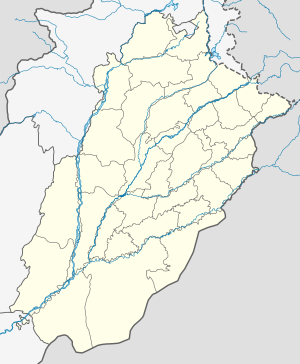| Badshahi Mosque | |
|---|---|
بادشاہی مسیت بادشاہی مسجد | |
 | |
| Religion | |
| Affiliation | Islam |
| District | Lahore |
| Province | Punjab |
| Year consecrated | 1670 |
| Location | |
| Location | Lahore, Punjab, Pakistan |
| Geographic coordinates | 31°35′17″N 74°18′34″E / 31.58806°N 74.30944°E |
| Architecture | |
| Type | Congregational mosque |
| Style | Indo-Islamic, Mughal |
| Founder | Aurangzeb Alamgir |
| Completed | 1673 |
| Specifications | |
| Capacity | 100,000 |
| Dome(s) | 3 |
| Minaret(s) | 8 (4 major, 4 minor) |
| Minaret height | 226 ft 4.5 in (68.999 m) |
| Materials | Red sandstone, marble |
The Badshahi Mosque (Punjabi: بادشاہی مسیت, romanized: Bādshā’ī Masīt; Urdu: بادشاہی مسجد, romanized: Bādshāhī Masjid) is a Mughal-era imperial mosque located in Lahore, Punjab, Pakistan.[1][2] It was constructed between 1671 and 1673 during the rule of Aurangzeb, opposite of the Lahore Fort on the northern outskirts of the historic Walled City. It is widely considered to be one of the most iconic landmarks of the Punjab.[3]
The Badshahi Mosque was built between 1671 and 1673 by the Mughal emperor Aurangzeb. The mosque is an important example of Mughal architecture, with an exterior that is decorated with carved red sandstone with marble inlay. It remains the largest mosque of the Mughal-era, and is the third-largest mosque in Pakistan.[4] In 1799, during the rule of Ranjit Singh of the Sikh Empire, the mosque's courtyard was used as a stable and its hujras (cells) as soldiers quarters. When the British Empire took control of Lahore in 1846 it was used as a garrison until 1852. Subsequently, the Badshahi Mosque Authority was established to oversee its restoration as a place of worship. It is now one of Pakistan's most iconic sights.[1]
- ^ a b Cite error: The named reference
AHAwas invoked but never defined (see the help page). - ^ Haroon Khalid (26 August 2016). "Lahore's iconic mosque stood witness to two historic moments where tolerance gave way to brutality". Scroll.in website. Retrieved 1 January 2021.
- ^ "Holiday tourism: Hundreds throng Lahore Fort, Badshahi Masjid". The Express Tribune (newspaper). 9 October 2014. Retrieved 1 January 2021.
- ^ Meri, Joseph (31 October 2005). Medieval Islamic Civilization: An Encyclopedia. Routledge. p. 91. ISBN 9780415966917.


